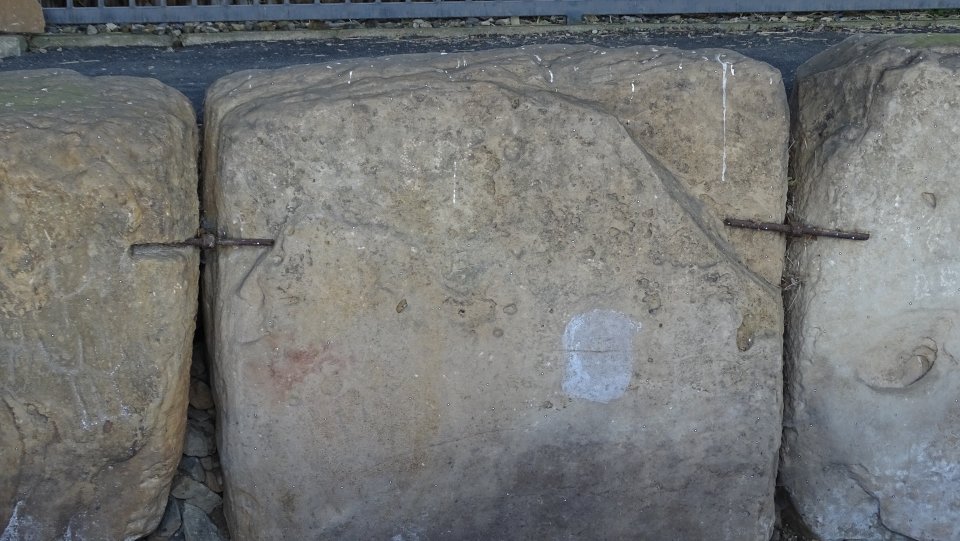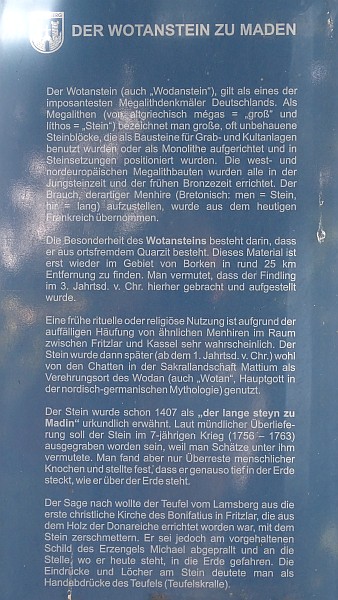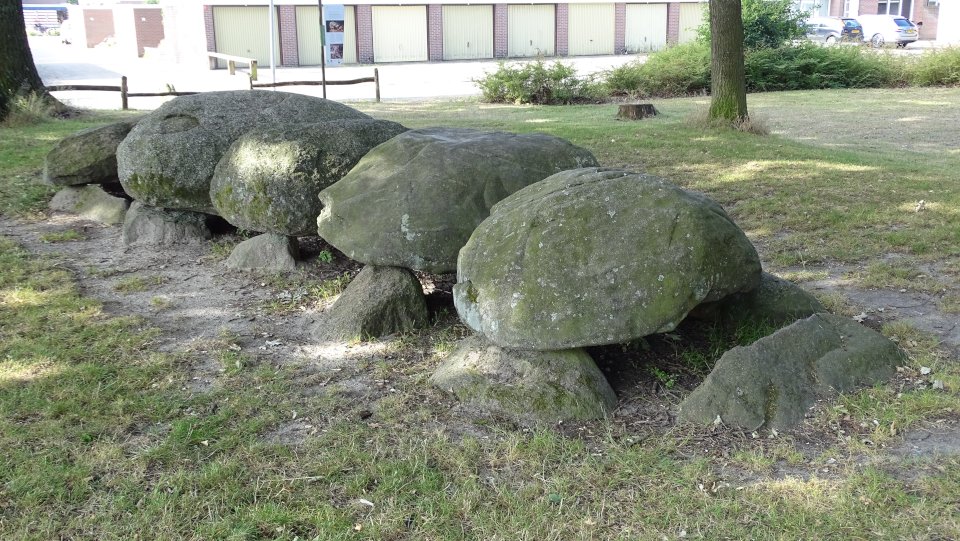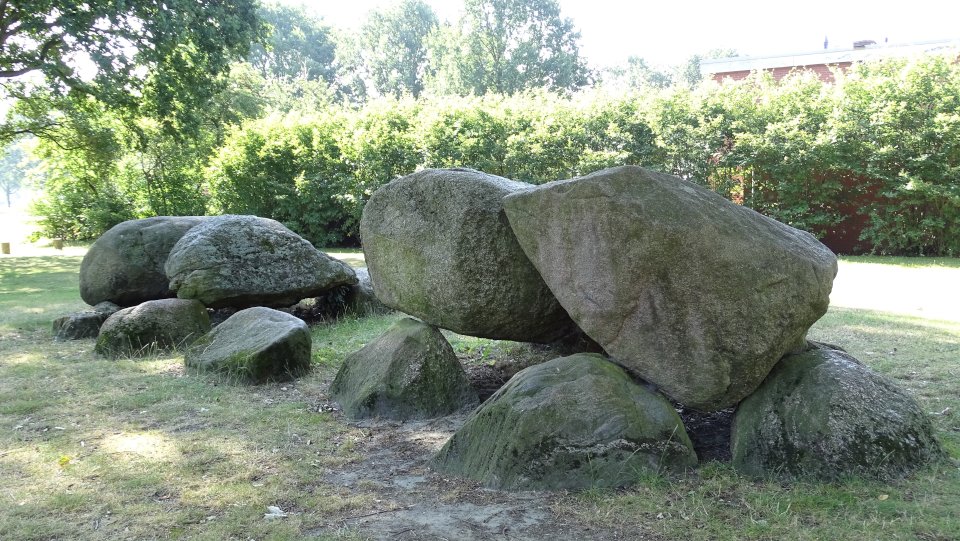






The menhir Hilgenstein is situated in the south of the village of Werkel, east of a development area in the street Am Hilgenstein.
The menhir is 1.5m high and 0.5m (base) respectively 0.3 m (top) wide. As there were no archaeological finds found nearby, it could not be dated beyound doubt. It is assumed that the current location is not identical to the original location.
Visited July 2018
Like its neighbour D46 Emmen (Angelslo), D47 Emmen (Angelslo) has been swallowed by the city of Emmen some time ago. I’m not a big fan of ‘urbanized’ megalithic sites, as I always find that they lack atmosphere, which is, beside the site itself, also important for me. In the case of these two Hunebeds I have to admit, that the impacts of the surrounding residential settlements are not too disturbing.
D47 Emmen (Angelslo) is a mid size Hunebed (6.9 x 2m), consisting originally of five capstones. In a restoration in 1997, two random boulders were added but not noticeable in the meantime anymore. The supporting stones and end stones are all present and are located almost entirely below the ground level.
The ‘official’ (signed) approach by car is to park in Heesackers street (around house no. 27) , which is right in the middle between the two Hunebeds and walk to each site from here.
Visited July 2018
Like its neighbour D47 Emmen (Angelslo), D46 Emmen (Angelslo) has been swallowed by the city of Emmen some time ago. I’m not a big fan of ‘urbanized’ megalithic sites, as I always find that they lack atmosphere, which is, beside the site itself, also important for me. In the case of these two Hunebeds I have to admit, that the impacts of the surrounding residential settlements are not too disturbing.
D46 Emmen (Angelslo) is a mid size Hunebed (9.5 x 3.6m), consisting originally of five capstones, the middle capstone is not present anymore. The supporting stones and end stones are all present.
The ‘official’ (signed) approach by car is to park in Heesackers street (around house no. 27) , which is right in the middle between the two Hunebeds and walk to each site from here.
Visited July 2018
D45 Emmerdennen is one of the most beautiful Hunebeds in The Netherlands. It is located on a small clearing in the woods, about 650m north of Scheper Zieckenhuis (hospital). Although the busy town of Emmen is nearby, the place emits a certain kind of tranquility and peace. The Hunebeds lies on a small hill, which also adds to the grandeur of this place.
It is one of the larger Hunebeds (18.5 x 4.5m), there are still six of originally nine capstones remaining (three capstone of the eastern section are missing) and two of the entrance stones. The eastern remaing capstone is remarkable large. From the originally 38 kerbstones only 13 are still present, 25 have disappeared.
Highly recommended!
Visited July 2018




The menhir Wotanstein is situated on the south-west corner of the village of Maden, east of the road K9, which leads from Maden to Obervorschütz. The site is signed, it is less than 50m from the road.
The menhir is 2.12m high, 1.2 m wide, and 0.55 m thick, it lies in a small clearing framed by hedges and trees.
Why a park bench with its back was set directly on the Menhir remains an eternal mystery to me. I would have placed it at a respectful distance and with a view on the menhir.
Visited July 2018
taken from the information board:
The Wotanstein in Maden
The Wotanstein (also “Wodanstein”), is considered one of the most imposing megalithic monuments in Germany. As megaliths (from ancient Greek megas = “large” and lithos = “stone”) one refers to large, often uncut stone blocks that were used as building blocks for grave and cultural facilities or erected as monoliths and positioned in stone settings. The Western and Northern European megalithic structures were all built in the Neolithic and Early Bronze Age. The rite of setting up such menhirs (Breton: men = stone, hir = long) was taken over from present-day France.
The uniqueness of the Wotanstein is that it consists of non-local quartzite. This material can only be found again in the area of ??Borken, around 25 km away. It is believed that the foundling was brought here and placed in the 3rd millennium BC.
An early ritual or religious use is very likely due to the conspicuous accumulation of similar menhirs in the area between Fritzlar and Kassel. The stone was then later (from the 1st millennium before Christ) probably used by the Chatti in the sacral landscape Mattium as a place of worship of Wodan (also “Wotan”, main deity in the Nordic-Germanic mythology).
The stone was first mentioned in 1407 as “the long stone at Madin”. According to oral tradition, the stone has been excavated in the 7-year War (1756-1763) because treasures were suspected under him. But only the remains of human bones were found, and it was realized that it was as deep buried in the earth as it is above the earth.
According to legend, the devil wanted to smash the stone from the Lamsberg on the first Christian church of Boniface in Fritzlar, which had been built from the wood of the Donareiche. However, it bounced off the pre-occupied shield of the Archangel Michael and drove to the place where it is today, into the earth. The impressions and holes on the stone were interpreted as handprints of the devil (devil’s claw).










with 3d model, short video (in Dutch), pictures and further information




What happened to the missing capstone?
Visited July 2018

with 3d model, short video (in Dutch), pictures and further information









Panorama view of Emmerdennen in its surrounding
Visited July 2018

with 3d model, short video (in Dutch), pictures and further information
The only special ‘feature’ of D44 Westenesch is the fact, that it is the only Hunebed in the Netherlands in private ownership. Apart from that, there are only a few remnants that should probably only be of interest to the Hunebed completionists among us.
Visited July 2018



